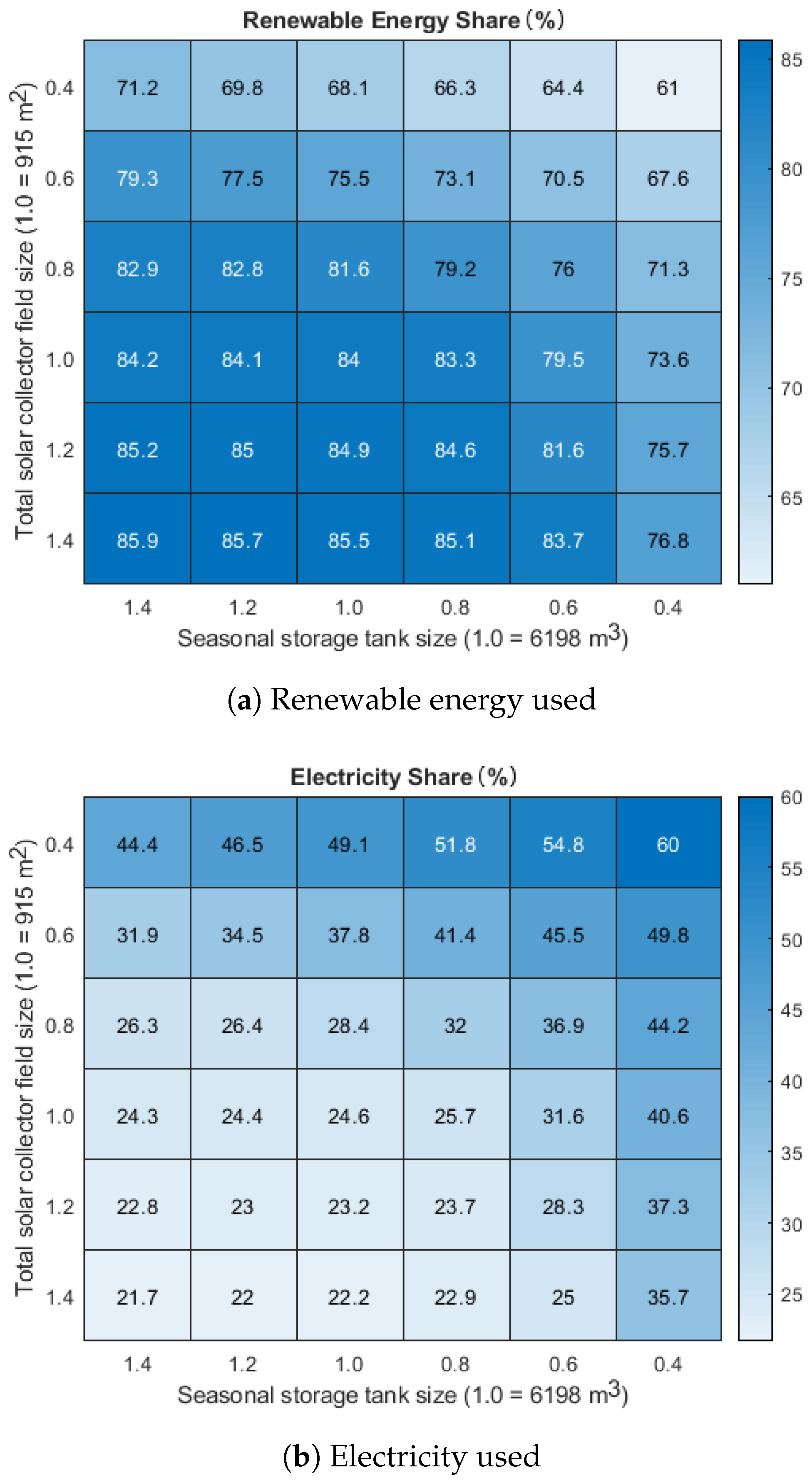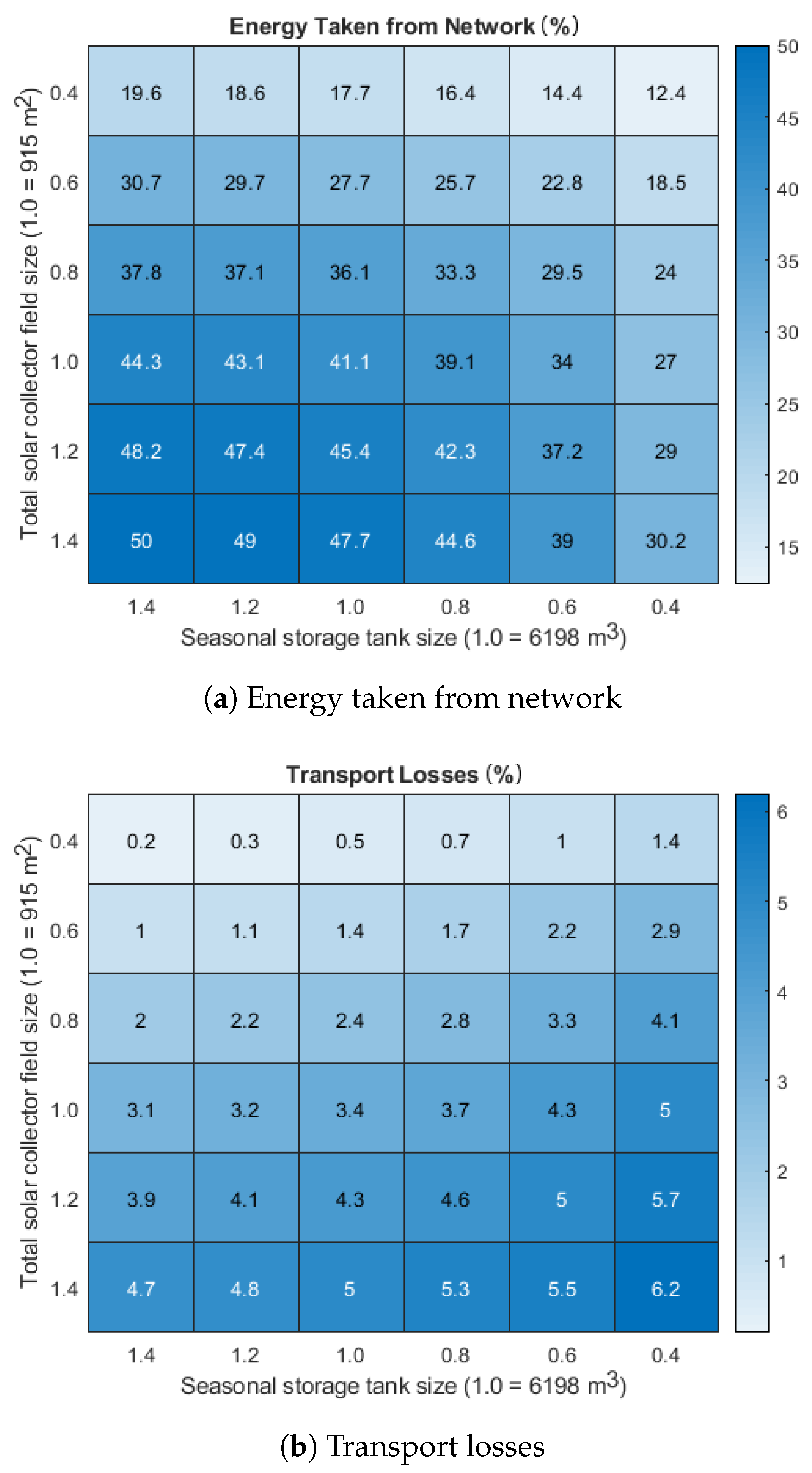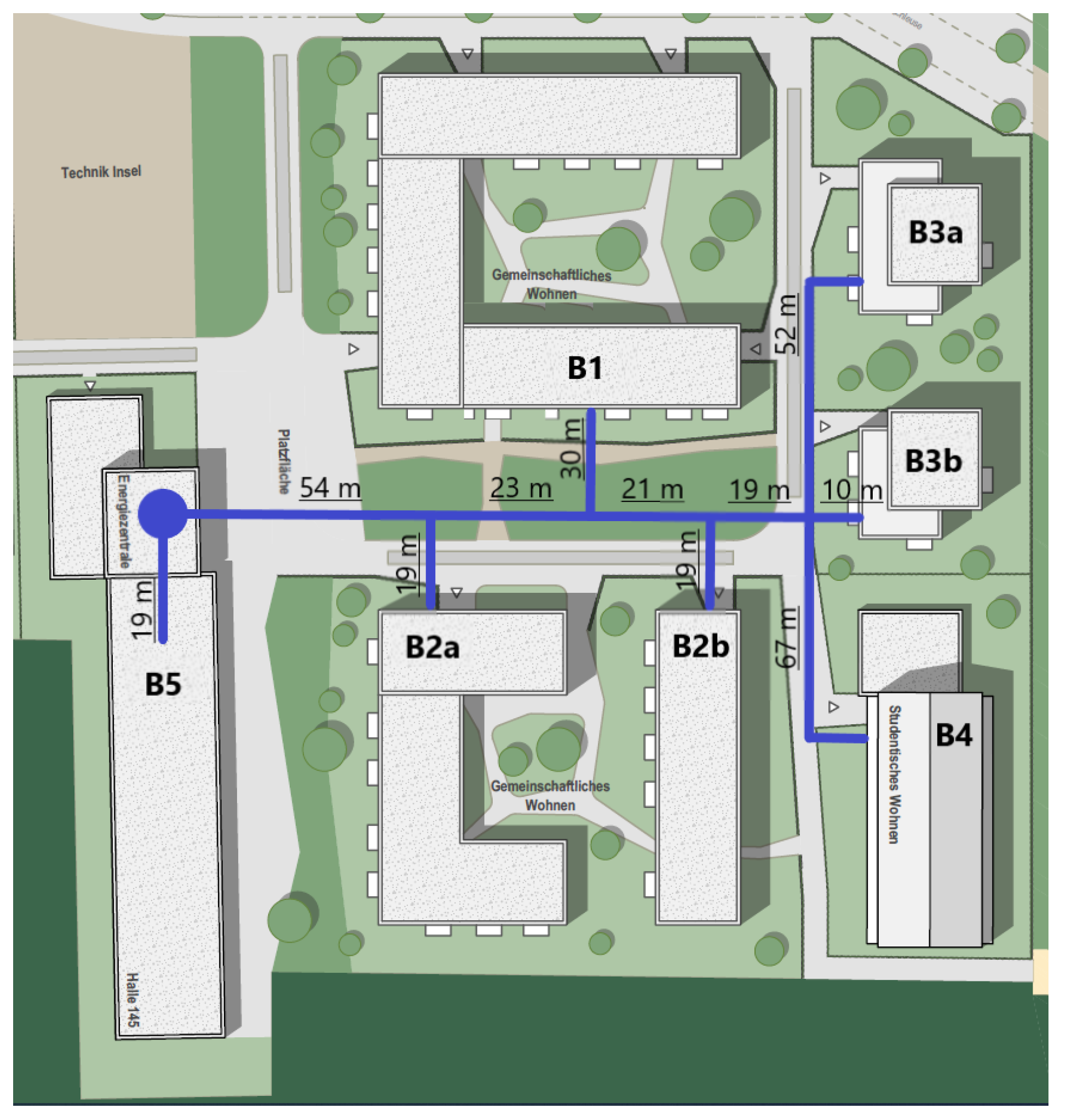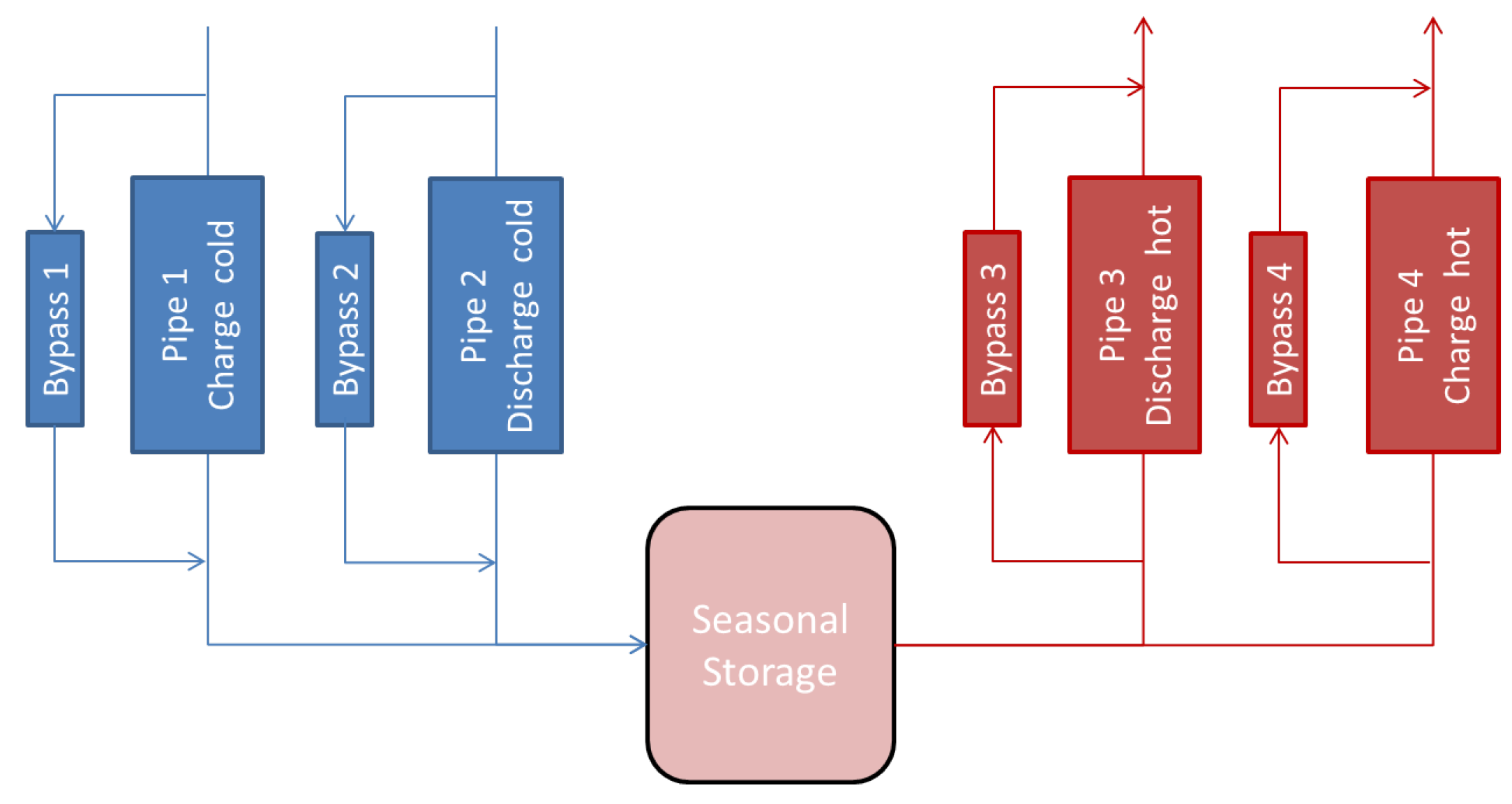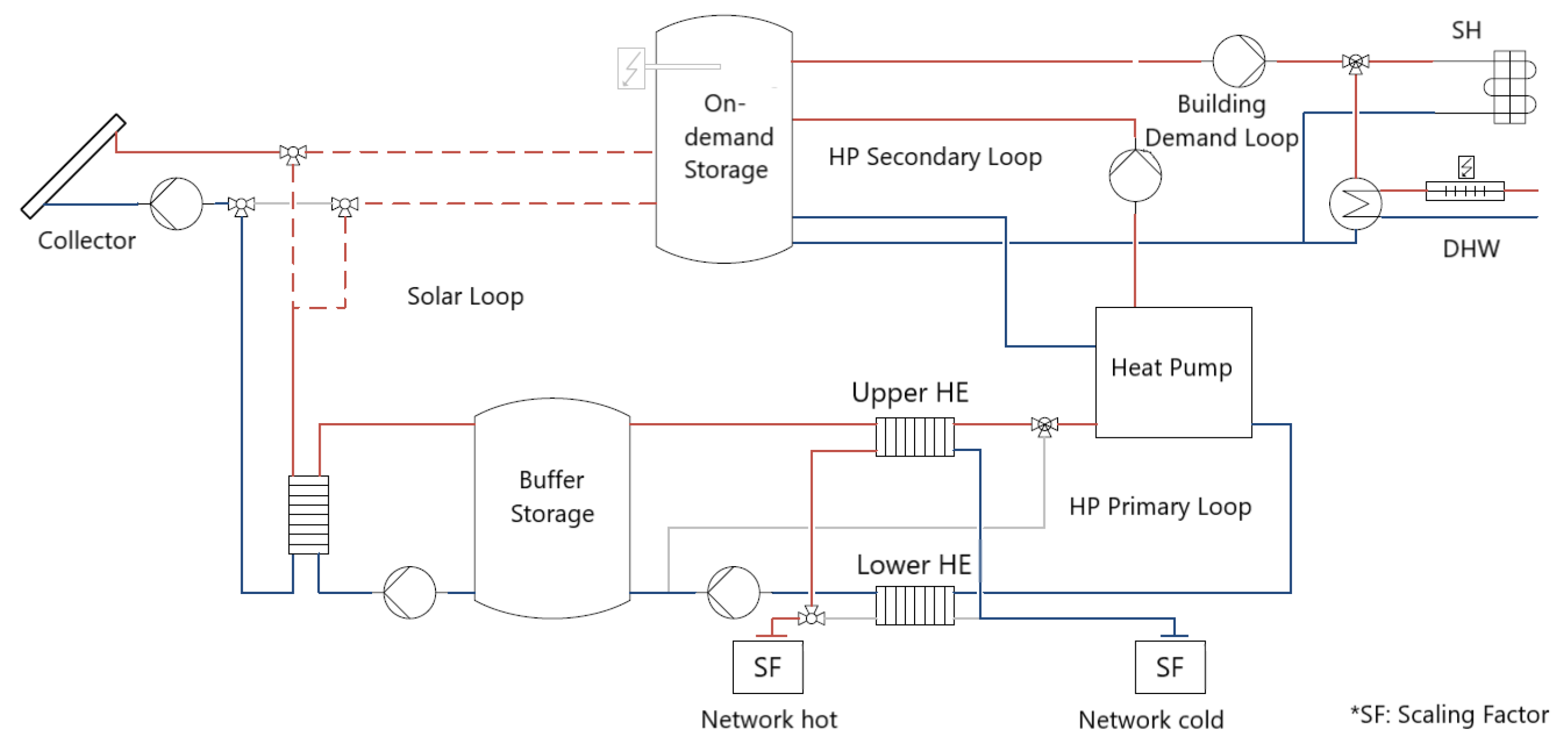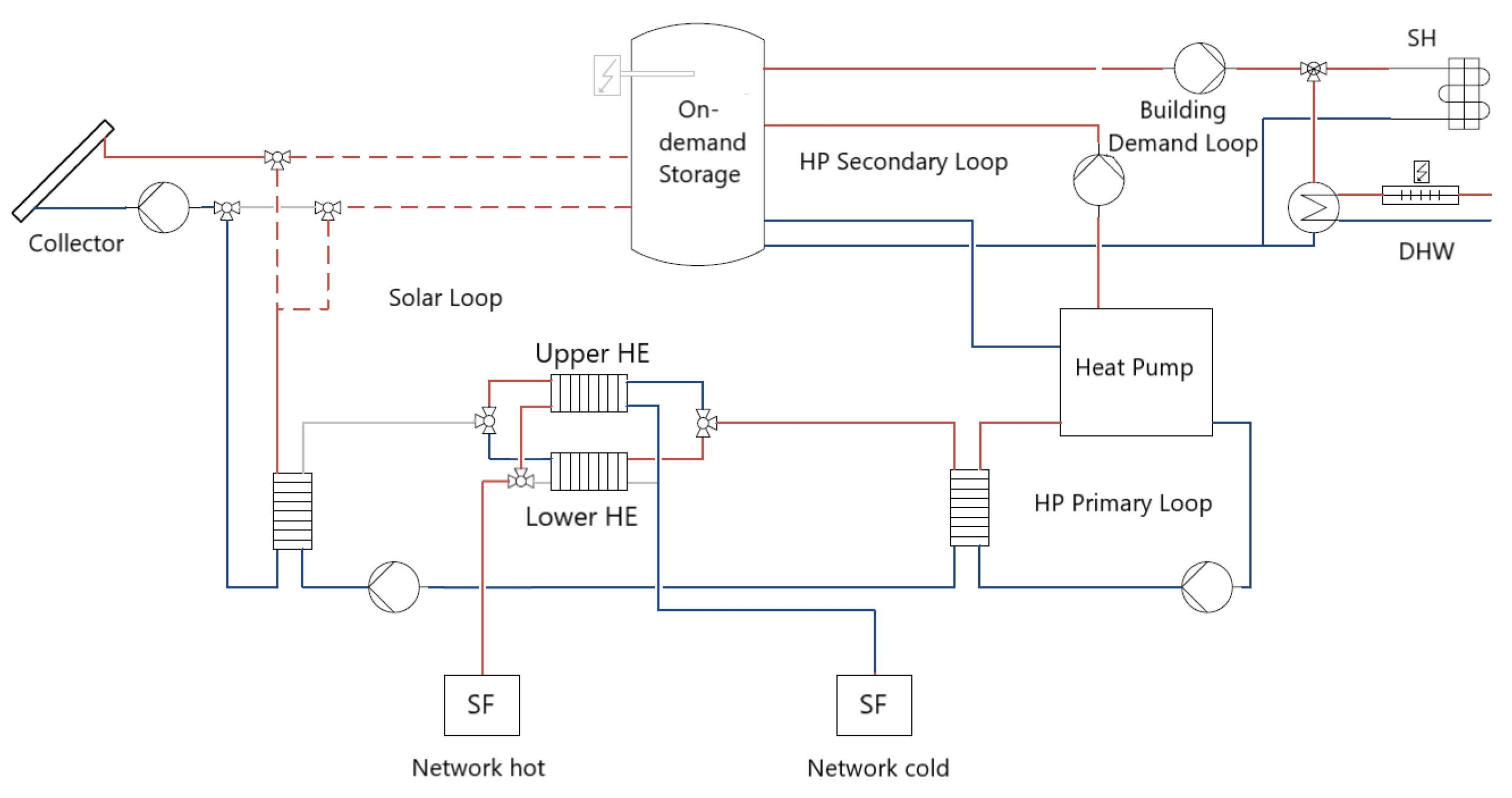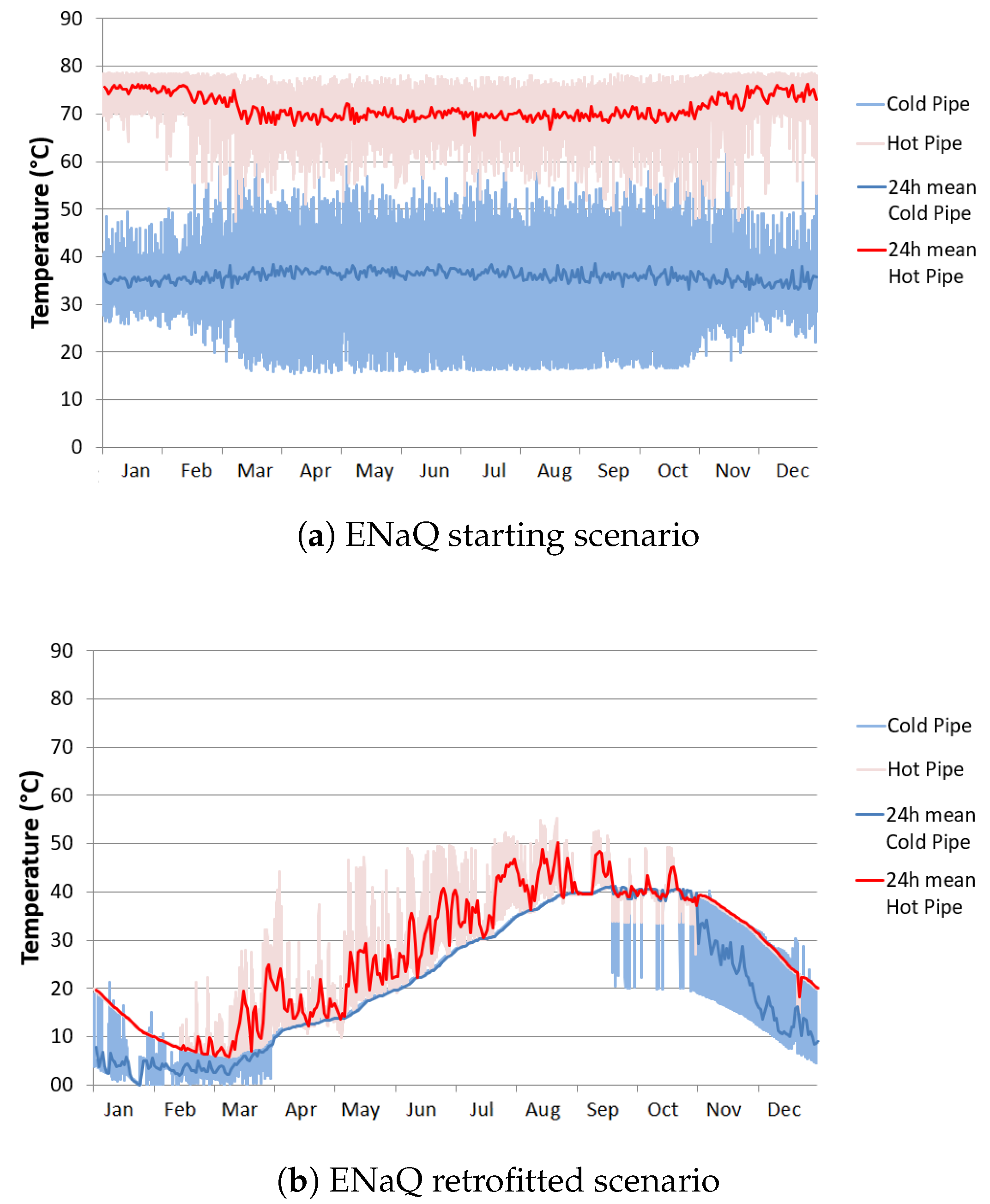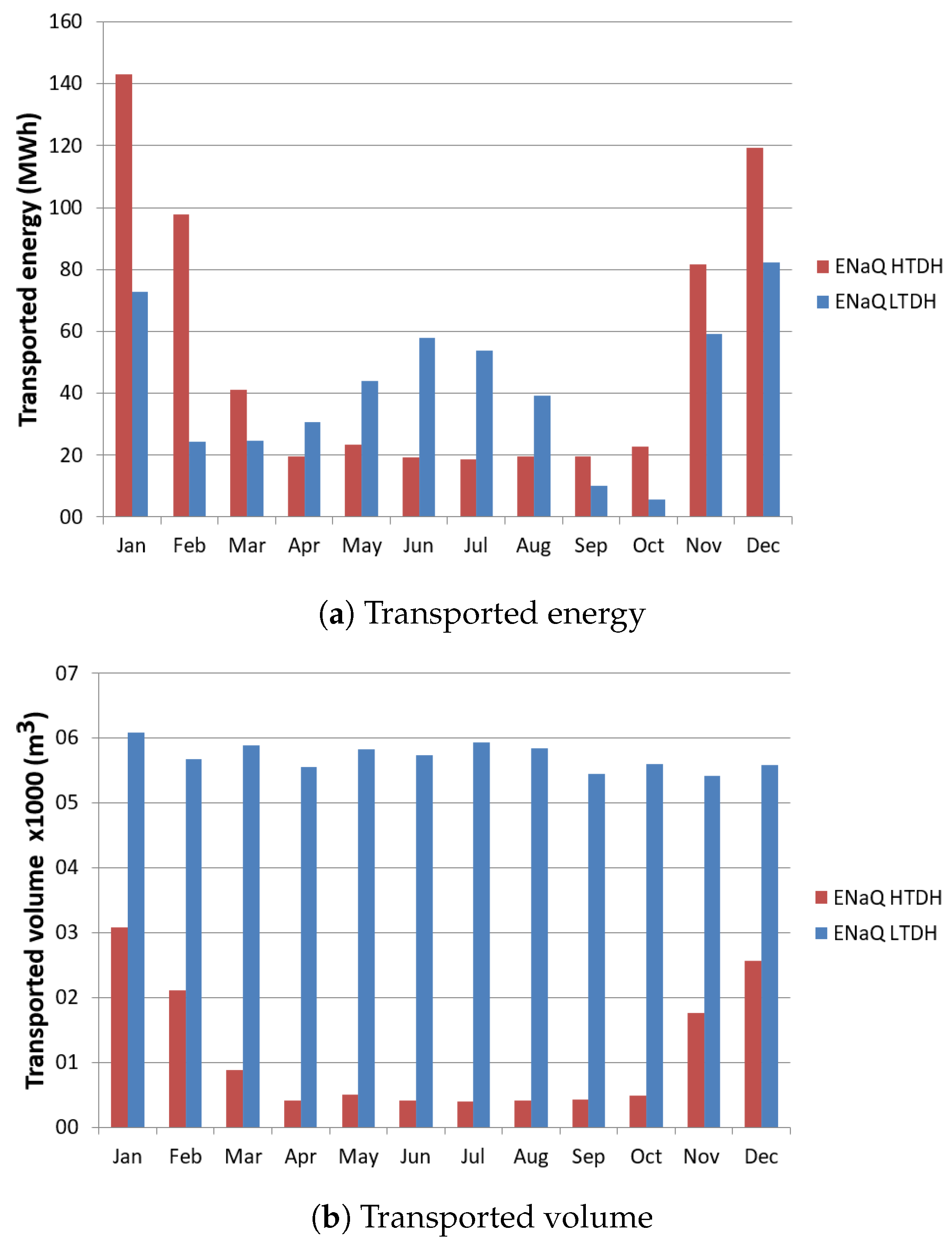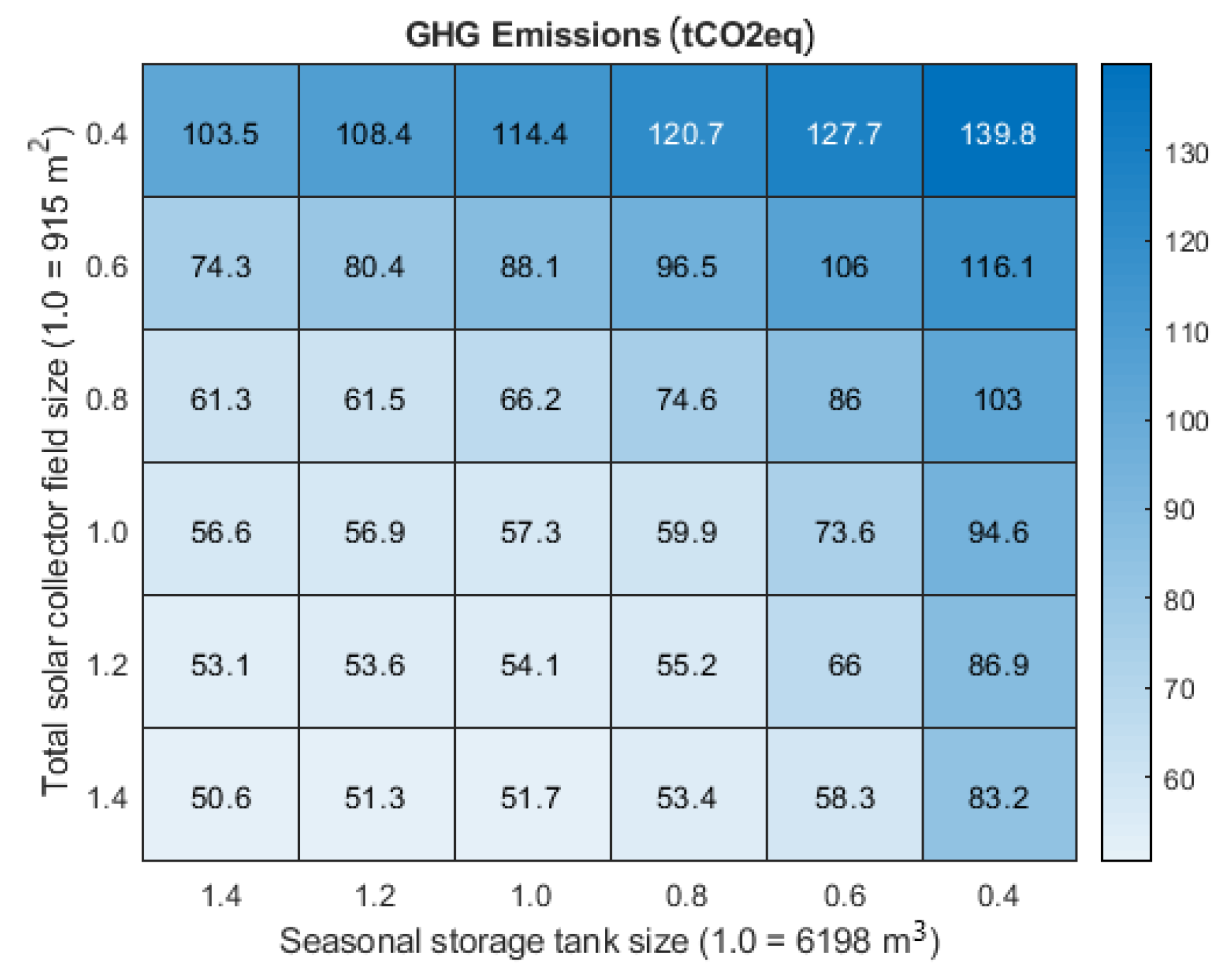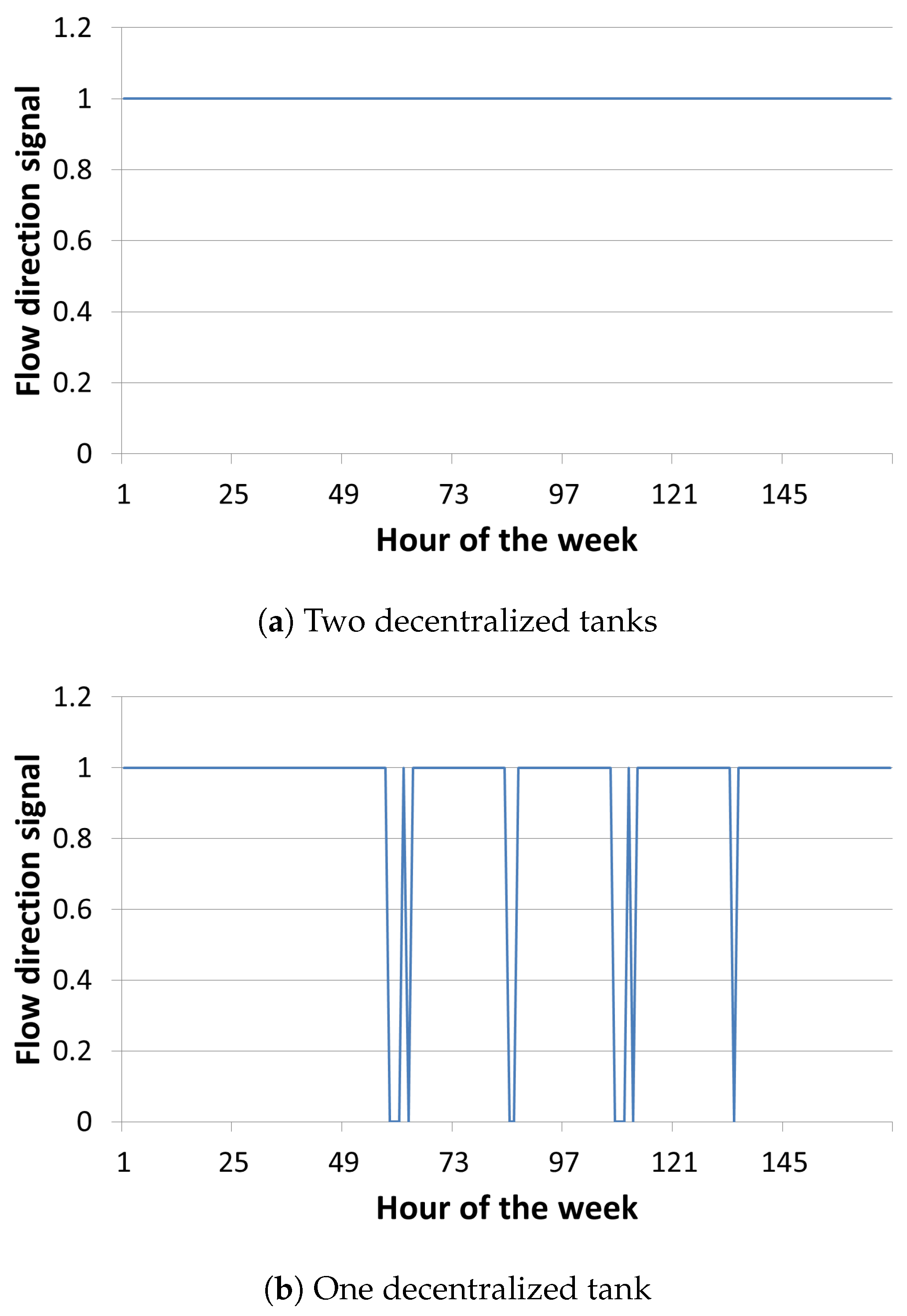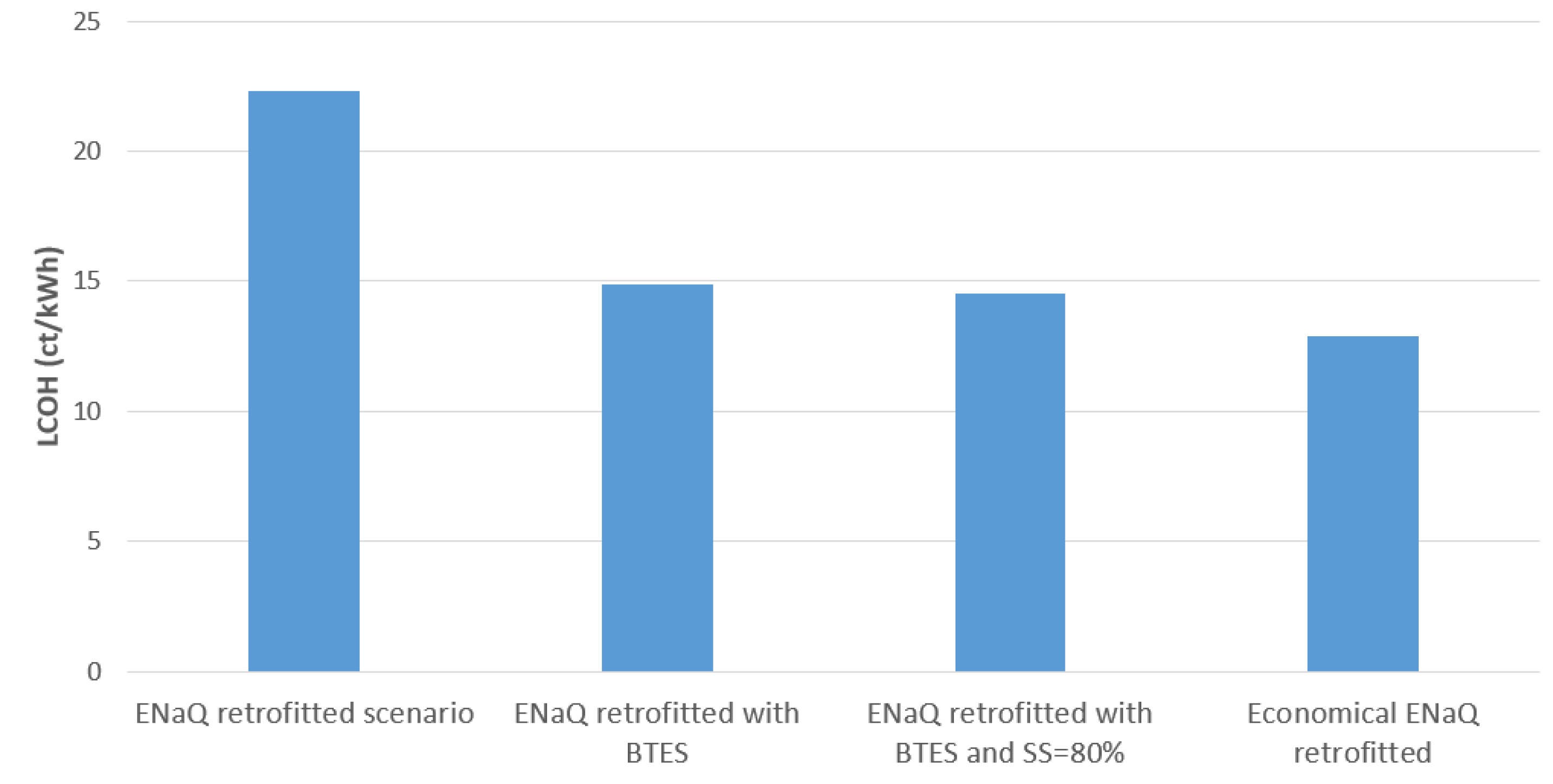Both scenarios, ENaQ starting and retrofitted were simulated for 1 year with an hourly time step. Then the sensitivity analysis was carried out and finally the economic comparison. Technical results are shown first followed by the economic ones.
4.1. Technical Comparison between ENaQ Starting (HTDH) and Retrofitted (LTDH) Scenario
The first comparison between both scenarios involved the temperature of the district heating system.
Figure 7 shows the temperature over 1 year for both systems where the red color represents supply and blue return temperatures. Temperatures are also presented as hourly and 24 h mean values since the hourly values were influenced by the scaling up factor. The reason of this influence lay in the single building model used in the Carnot Toolbox, which meant that all the heat transfer processes between the buildings and the district network happened at the same time and point: where the scaling factor was placed. In reality these processes happened separately in each connection between building and network making the temperature levels much smoother. Because of this, from now onwards the 24 h mean parameter was used to compare both systems.
ENaQ starting scenario had almost constant supply and return temperatures of 75 C and 35 C throughout the year. This is explained by the CHP control strategy which turned on when the centralized storage temperature fell until 70 C and fed it with water at 80 C. This 10 C gap could be observed in the hourly values in winter while in summer because of lack of SH demand the return temperature adjusted to the domestic cold water 15 C) thus reducing its value. Concerning the return temperature, the reason of having a constant 24 h mean value lay on the mass flow strategy designed for this HTDH model. The mass flow in the district network was adjusted to have a temperature difference of 40 C between supply and return, and since the supply temperature was constant, then return temperature must also have been.
On the other hand, the temperature behavior in ENaQ retrofitted scenario was dynamic throughout the year. Supply temperature had a minimum value of 7 C in March which began to rise until it reached a maximum of 48 C in September. This temperature increase was due to the solar collector gains happening in each building which were transported through the network to the seasonal storage. After 1 month with a constant value of 40 C where each building could meet its demands without taking or giving energy to the seasonal storage, in November the temperature level started to fall until it returned to the minimum in March. This happened because the buildings were taking energy from the seasonal storage since they could not meet their heat demands by themselves. Return temperature had a similar trend of supply explained by the same strategy mentioned above. The maximum value reached was 40 C in October, which started to fall until reaching its minimum of 1 C in January. The most frequent minimum value for the return pipe was 4 C, being maintained until the end of March when it started to rise again.
When comparing these two temperature levels, there were two main differences to highlight. In the first place, the different temperature levels in each system and secondly that the difference
was much less in ENaQ retrofitted than starting scenario.
Figure 8 helps to explain these differences, where the monthly transported energy and volume through the district network for both scenarios is shown.
The transported energy through the network explained the different temperature levels of both systems. In the ENaQ starting scenario the transport of most of the energy happens in winter, when SH was higher, reaching a peak of 143 MWh in January. In summer there was only DHW demand and it maintained a value around 20 MWh. On the other hand, the ENaQ retrofitted scenario had two peaks, one in winter reaching a peak of 81 MWh when buildings were taking energy from the seasonal storage and another one in summer when buildings were giving energy. In October when each building was able to meet its own demand, the transported energy reached a minimum of 6 MWh. Thus the role played by the district network in each scenario was totally different which led to the different temperature levels: for the ENaQ starting scenario it was a means of energy transport from the centralized source to the decentralized demands while in ENaQ retrofitted it was a connection between the decentralized energy sources and a centralized seasonal storage.
Observing the low difference for ENaQ retrofitted scenario, and knowing that the specific heat of the water was a constant, the only way to have such an energy transport was by an increase of the transported volume of water. As can be seen in the monthly transported volume, ENaQ starting scenario followed the trend of the energy demand, thus maintaining a constant all the year long. ENaQ retrofitted scenario maintained a higher and more constant transport volume. This was only possible due to decentralized storage tanks placed on each building which allowed a water and therefore energy transport when was not required and buffer peak demands making the energy transport much smoother. Moreover decentralized storage tanks allowed storing the decentralized generated heat in each building for short periods of time (hour scale). It is important to remark that this high transported volume always maintained the maximum water velocity constraint for which the district network was originally designed. In other words, the ENaQ starting scenario had few peaks where the maximum water velocity was reached while ENaQ retrofitted scenario operated constantly at values close to this threshold and with that, was able to transport more water through the district network.
Due to the possibility of reducing the and the role that the district network took in one and the other scenario, this transformation was not only about replacing non renewable energy sources by renewable ones but also about changing the district heating system concept.
Continuing with the district heating system comparison
Table 4 shows the five KPI for both scenarios.
The ENaQ starting scenario operated almost without renewable energy sources or electricity. This is explained by the CHP based design which operated with natural gas. The small amount of renewable came from the electricity used at the electric water heater placed at the DHW for peak loads. Moreover, the CHP was centralized and also the only heat generation source, therefore practically all the energy used was taken from the network reaching 98.9% of the energy coming from it. With this and the high network temperatures provided by the CHP, transport losses represented 8.3% of the generated energy which meant 52.7 MWh. The high amount of GHG emissions came mainly from the natural gas used.
The high amount of renewable energy sources used in ENaQ retrofitted scenario was caused by the replacement of the CHP with solar collectors (a total renewable energy source) and heat pumps (a partial renewable energy source). The electrification of the supply system increased to almost one quarter of the total energy due to the inclusion of heat pumps. If 41.1% of the energy was taken from the network, it meant that 58.9% of the demand was met at the same time and place where it was produced. The reason of that was the decentralization of the heat sources in the system. A reduction of 59% of transport losses occurred mainly but not only because a reduction of the network temperature. The second reason for achieving this reduction was because there was less energy transported through the network than in the ENaQ starting scenario. The ENaQ retrofitted scenario transported 238.7 MWh from the seasonal storage to the buildings and 265.5 MWh from the buildings to the storage, making 504.2 MWh in total, while the ENaQ starting scenario transported 626.2 MWh from the CHP to the buildings. Finally, when looking at the GHG emissions, a reduction of 57.6% was achieved because despite the fact that the share of renewable energy sources increased from 0.3% to 84%, the electrification of the system increased too, which had higher emission rates than the natural gas.
After analyzing in detail both ENaQ starting and retrofitted scenario it can be said that the improvement of the retrofitted scenario was considerable. An increase of renewable share from 0.3% to 84.0% of the covered demand, reduction of transport losses from 8.3% to 3.4% of the generated energy or reduction of GHG emissions of 57.6% support the previous statement and under these KPI makes this district transformation worthwhile.
The last point to address in this section is how close ENaQ retrofitted scenario to ENaQ aiming was. To do that ENaQ retrofitted was compared with the LTDH reference scenario developed at the beginning of this study and which was based in the TUM study [
21]. This means that the district heating system was different than ENaQ and therefore from all five KPI, neither transport losses can be compared, since the network topology was different, nor the GHG emissions, since the demands were different too. To cope with that problem, these KPI were normalized with the equivalent length
and the total demand as
Table 5 shows.
The first three indicators had a difference of only 3.1% in average while for transport losses and GHG emissions there was a slight increase on the LTDH reference scenario. The reason why ENaQ retrofitted seemed to be better than ENaQ reference lies in the weather data used on each model. While ENaQ retrofitted used Oldenburg data from year 2018, LTDH reference scenario used Stötten (Bavaria, Germany) data from years 1988 until 2007. Stötten data were selected for the reference scenario since in the Carnot Toolbox is the closest city to Munich where the TUM model [
21] was performed [
22] (p. 34). This place and more important year difference led to higher direct radiation in Oldenburg, which led to an increase the share of renewable energy sources as well as energy taken from network and consequently decreased the electrification, GHG emissions and transport losses.
Knowing that the LTDH reference scenario in this case corresponded to the ENaQ aiming scenario, the above means that the question established in the introduction has an answer: ENaQ starting scenario can be retrofitted until it became ENaQ aiming scenario. There were three key points that allowed this transformation to happen. First, having decentralized sources reduced the energy required from the district network. Second, having decentralized storage tanks allowed higher and more constant transported volume through the network. Finally, having a heat pump on each building right before the outlet to the network allowed a reduction of the return temperature to lower levels than the domestic cold water and consequently a reduction of the supply temperature. These mechanism maximized the difference but in temperature levels around 4 C and 40 C which meant having a low temperature district heating system. These three key points together allowed us to comply with the water velocity constrain even when the difference reduces.
4.2. Sensitivity Analysis of ENaQ Retrofitted Scenario (LTDH)
In this subsection, results are presented for cases when the transformation could not be 100% performed. First results with different values of collector field and seasonal storage tank are presented. Then results are shown for cases when the buffer storage could not be placed.
4.2.1. ENaQ Retrofitted with Different Solar Collector Area and Seasonal Storage Tank Volume
Here scenarios were simulated with different solar collector area or seasonal storage. For each scenario the five KPI were calculated and
Figure 9 shows as an example the GHG emissions indicator. The other four indicators are presented in
Appendix A. The size of the variables ranges from 40% (0.4) to 140% (1.4) of the reference which was the ENaQ retrofitted scenario.
The first point to mention is that as the size of the solar collector field or the seasonal storage grew, the emissions decreased. To explain that is necessary to know that the GHG emissions came only from electricity which was used either by the heat pumps or the electrical water heaters. Therefore if the solar collector area increased, then solar energy yield increased, leading to a reduction in the energy required from the heat pump and consequently the GHG emissions. Concerning the seasonal storage, a bigger volume led to an increase of its heat capacity, reducing the temperature level for the same amount of stored energy and subsequently transport losses were reduced. In consequence, the solar fraction increased leading to a reduction of the electricity demands for the heaters and heat pump and to a decrease in the GHG emissions.
The second point to mention is that the influence of any of these two variables was not linear. The bigger the solar collector field iswas the lower the influence of the seasonal storage in the GHG emissions: when the collector size was 1.4 times bigger than the reference case, a reduction of the seasonal storage size from 140% to 40% of the reference case increased the emissions by 64.4% but when the collector size was 40% of the reference case, the same seasonal storage variation increased the emissions by 35.1%. The same principle applies when fixing the seasonal storage tank volume. For the solar collector this is explained by the minimum energy required to turn on the match flow pump: with smaller areas, this threshold was more difficult to reach in order to turn it on. Due to this, on some days where in the base case the collector pump was on, now it was off. Similar to the first point, less use of solar collector meant more use of heat pump or water heater and more emissions. For the seasonal storage it had to do with the temperature difference between the soil and the district network: with smaller seasonal tank sizes, the district network temperature increased more, making losses higher. When the seasonal storage was big enough (e.g., reference case) this temperature difference became increasingly irrelevant to the point where it could no longer be reduced. This energy loss came only from the solar collector, which meant that heat pump or water resistor needed to cover this deficit, leading to increased emissions.
These two points meant that bigger sizes of solar collector fields or seasonal storage tanks, allowed them to increase the use of solar energy, and therefore reduce the energy that needed to be covered by electricity. However, the electricity share indicator, and consequently the emissions indicator, could never be equal to zero since a key component of the system, the heat pumps, made use of electricity. The previous meant that the electricity used on the system could be divided into two components: the one which went to the heat pumps, and the one which went to the electric water heaters. The first component could not be removed while the second one can be, if the variable sizes were big enough. It is important to remark that emissions were a fixed rate from the grid electricity (401 g/kWh) and in the future this value will decline making ENaQ retrofitted to emit less and less.
Under the heat maps generated for each KPI, it was possible to generate guidelines for when the transformation could not be 100% performed. It is important to remark that each indicator had its own behavior which meant that for following a specific indicator it was necessary to look only at its specific heat map. Said that the following guidelines were developed taking under consideration the five KPI:
Guideline for when the seasonal storage tank was limited: if the size of it was 80% of the nominal value, the transformation was worth it presenting small declines on its performance. If the size was 60% of the nominal value, the problem could be solved by increasing the size of the solar collector field at least 20% of its nominal value. If the tank size was 40% of its nominal value or lower, it is likely that the transformation was not feasible since there was a fall of 44.8% of the system performance compared with the reference case.
Guideline for when the solar collector field was limited: if the field size was 80% of the nominal value, again there were no big problems for performing the transformation. If the field size was 60% of the nominal value, the transformation may not be feasible, even when the size of the seasonal storage tank increased. If the solar collector field size was 40% of the nominal value, it is likely that the transformation was not feasible since there was a fall of 38.0% of the system performance (55% without transport losses indicator) compared with the reference case.
Guideline for when both the seasonal storage tank and the solar collector field were limited: if both sizes were 80% of their nominal values, the transformation was worth doing presenting small declines on its performance. If both values were 60% of the nominal values, the transformation may not have been feasible. If both values were 40% of their nominal values, then the transformation was definitely not worth it since the emissions were higher than the HTDH scenario.
4.2.2. ENaQ Retrofitted with Only One Decentralized Storage
Table 6 shows the five KPI for ENaQ retrofitted with one and two decentralized storage tanks.
Starting by the share of renewable energy sources, scenario with one decentralized storage had a slight decrease from 84% to 78.5%. This was due to less energy coming from solar collectors which was covered by electricity. This less energy from collectors occurred when they reached a temperature above 25 C and the heat pump was on. In that situation, solar collectors stopped gaining energy and started to discharge the energy gained until this point to the seasonal storage through the district network which had a limited capacity of transporting energy and as a result 32.1 MWh of solar heat were dumped in comparison when there was a buffer storage. The increase of electricity used in the system had two reasons. On one side, in the same situation described above, the lower heat supplied by the heat pump was covered by the electric water heater placed inside the on-demand storage which needed more electricity for providing the same amount of heat. The second reason involved the heat pump. In the two storage system, the buffer storage was the inlet to the heat pump. This buffer storage was hot at the top and cold at the bottom. Solar gains kept the top of the buffer storage tank around 20 C in winter, allowing an efficient operation of the heat pump. The temperature at the top of the buffer storage only started to decrease in mid-February after the heat pump worked continuously throughout January and even there, some solar gains increased the temperature for some hours. Without the buffer storage, the inlet temperature for the heat pump due to its direct connection to the seasonal storage. Moreover, solar gains had to be used in the very same time they were produced, because there was not storage option for them. This decrease in the inlet temperature of the heat pump led to a reduction in its COP, increasing the electricity required and the resulting GHG emissions.
The energy taken from network decreased from 41.1% to 35% due to the inlet temperature limitation in the heat pump and the solar energy dumped as a result. The reduction in the energy transported in the network as well as the lower network temperatures led to a strong of the network heat losses from 20.7 MWh to 10.8 MWh. As said before the cut off in winter when the collector field reached 25 C reduced the energy sent to the seasonal storage and therefore the energy taken from it. Finally because of less energy transported in the district network along with the impediment to overcome temperatures higher than 25 C in most part of the year, led to a strong losses reduction from 20.7 MWh to 10.8 MWh.
From a general perspective the system performance with only one decentralized storage was moderately affected: when all five KPI were observed, taking into account that the transport losses indicator had a performance increase of 47.1%, the one storage system losses had 8.8% performance in comparison with the two storage system. When the transport losses indicator was taken out, the system had a drop in performance of 22.8%. Nevertheless the mayor challenge with this system configuration was the daily change of the mass flow direction in the district network in winter.
Figure 10 shows the control signal for the flow direction in the district network for the first week of February in an hourly time step. A flow direction signal of 1, meant the building was taking energy from the seasonal storage while a flow direction signal of 0 meant the building was giving energy to the seasonal storage changing the direction of the mass flow.
For the system with two decentralized storage tanks, the signal had a constant value of 1, which meant that the mass flow had the entire week the same direction: from the seasonal storage to the buildings. On the other hand, in the system with one decentralized storage tank, there were 4 of 7 days where the solar collector field reaches temperatures above 25 C and therefore the direction of the mass flow needed to change for 1 or 2 h until the collector outlet temperature returned to levels below 25 C. This change of mass flow direction represents a hydraulic challenge that needs to be studied in detail and is the main issue for using one decentralized storage tank.
4.3. Economic Comparison between ENaQ Starting (HTDH) and Retrofitted (LTDH) Scenario
Table 7 shows the levelized cost of heat for ENaQ starting and retrofitted scenario. Here it can be observed that the cost of each kWh was 4.46 times bigger for ENaQ retrofitted scenario, so with current economic conditions it was hard for an innovative and efficient district heating system to compete with ENaQ starting scenario (based on centralized CHP) under these conditions.
In order to make ENaQ retrofitted more economically competitive, three main changes were made that reduced its LCOH and are listed as follows:
The seasonal storage from PTES to BTES: the original pit thermal energy storage was replaced by a borehole thermal energy storage. In order to store the same amount of energy a volume of around 13,000 m
of ground was needed, which could be achieved with deep probes [
27,
28]. This technology not only needed lower investment costs but it also had a longer lifetime.
Reduce the seasonal storage to 80% of its nominal value: the sensitivity analysis performed with different solar collector area and seasonal storage volume showed that the best case, economically speaking, was when the seasonal storage was 80% of the nominal value and the solar collector area 100%. This was due to a stronger reduction in the investment cost of the seasonal storage while the electricity needed remained around 25%. When reducing the seasonal storage to lower values, then the electricity demand increased making the solution more expensive.
Replace solar collectors for photovoltaic thermal collectors (PVT): when using PVT the heat output of the solar collector decreased but the electricity produced could be used by the heat pumps. Since PVT made use of solar radiation, most of electricity generation occurred in summer when heat pumps did not work. Because of that the electricity consumption of the system decreased only by 15% but in this scenario the electricity sold in summer decreased the LCOH considerably since the same principle for the CHP electricity generation was applied here too.
With this three main changes, a new scenario was described where the focus was not only on improving the KPI, but also reducing the LCOH as much as possible. This new scenario was called Economical ENaQ retrofitted and
Figure 11 shows the LCOH of it along with the intermediate steps to show the impact that each change had.
The previous figure shows that replacing the PTES tank with a BTES had the greatest impact on reducing the LCOH, lowering it from 22.3 to 14.9 ct/kWh which meant a reduction of 33.2%. This happens because the seasonal storage implementation was the largest investment that had to be made to achieve the district heating transformation. Using a seasonal storage of 80% of the nominal value (4958 m of water equivalent) had the least impact on reducing the LCOH, lowering from 14.9 to 14.5 ct/kWh which means a 1.8% reduction with respect to ENaQ retrofitted scenario. Finally, replacing solar collectors by PVT had a moderate impact on the LCOH reduction, lowering it from 14.5 to 12.9 ct/kWh which meant a 7.2% reduction with respect to ENaQ retrofitted scenario.
The idea of having a big centralized heat pump or solar collector field is attractive since the investment and maintenance costs would be much lower, due to economy of scale. Nevertheless this would mean that all the energy came from a centralized heat source which would increase the energy transport through the network and therefore it would require bigger pipe diameters (transport the same amount of energy as ENaQ starting scenario but with lower temperatures). This would force to change the district network, which would again increase the investment costs.
After obtaining the best scenario in economic terms to perform the district heating transformation,
Table 8 shows a summary of the levelized cost of heat for ENaQ starting, retrofitted and economical ENaQ retrofitted scenarios.
The values of this table show that even the best technology combination for ENaQ retrofitted had a LCOH twice as high as ENaQ starting scenario. This was due to the low natural gas price for big costumers in Oldenburg which meant that currently, the CHP alone generated profits (running at full load for 1 h cost 4 of natural gas plus 1.25 of maintenance plus 0.8 of carbon tax and generated 5 of heat plus 7 of electricity). If the gas prices were the same as for normal citizens in Germany, 5.3 ct/kWh for multi family houses and 6.0 ct/kWh for single family houses, then the LCOH for ENaQ starting scenario would be 9.2 ct/kWh and 10.3 ct/kWh respectively, being on the range of those from the economical ENaQ retrofitted scenario. Furthermore a natural gas price of 7.7 ct/kWh would be required for ENaQ starting and economical ENaQ retrofitted to have the same LCOH.
This study compared a low cost, fossil fuel and high temperature technology with an expensive, renewable and low temperature technology. The comparison shows that a renewable innovative and efficient district heating system could hardly compete with standard fossil-based high temperature solutions under current economic conditions.
Following the goal to reach carbon neutrality in 30 years, in line-among others-with “Climate Action Plan 2050” the gas used by the CHP must at least come from renewable energy sources, such as power to gas technologies or biogas. This would make the gas price much more expensive than the current one and change the economic viability or the LTDH strongly.
